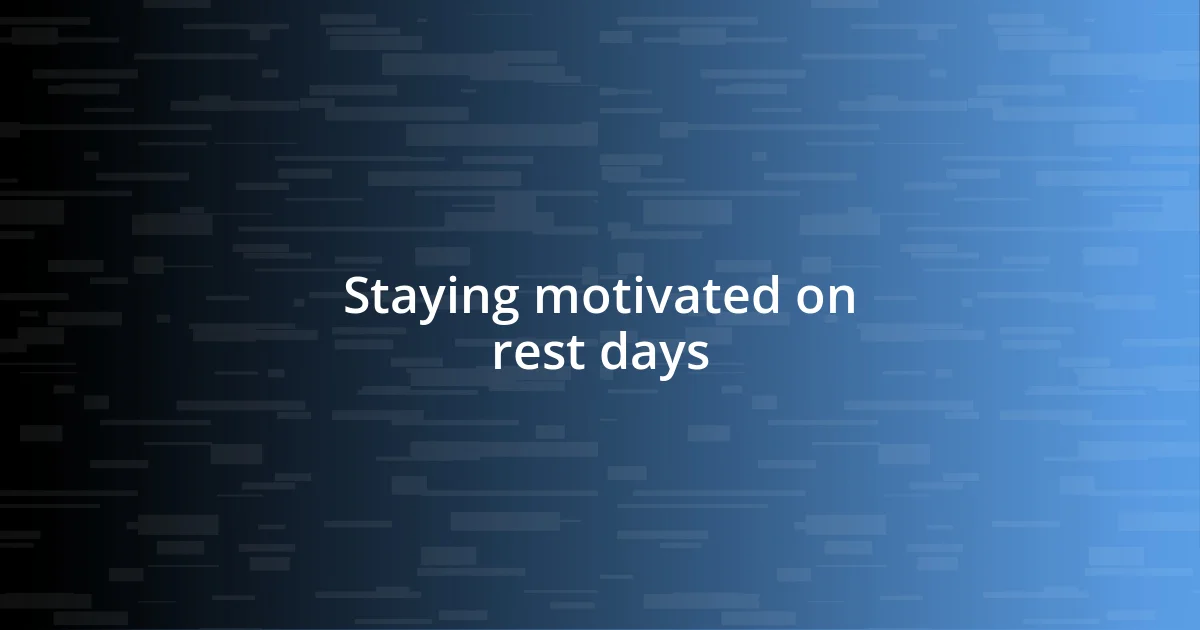Key takeaways:
- Active rest days allow for recovery through low-intensity activities, promoting both physical and mental well-being.
- Listening to your body signals, such as fatigue and soreness, is essential for optimizing recovery and avoiding injury.
- Incorporating variety and mindfulness into rest days can enhance motivation and maintain momentum in a balanced workout routine.

Understanding active rest days
Active rest days are all about giving your body a break from high-intensity workouts while still keeping it engaged. I remember when I first discovered the magic of these days; I felt guilty for not hitting the gym hard, yet my body craved something different. Have you ever felt that? It’s a balance—allowing your muscles to recover while still moving in a way that feels refreshing.
On these days, activities like walking, yoga, or light cycling can be incredibly beneficial. I had an eye-opening experience when I decided to go for a gentle hike rather than my usual sprint session. It was surprising to realize how refreshing a leisurely pace could be. It reminded me that movement doesn’t always have to be intense to be effective.
I find that the mental aspect is just as important as the physical. It’s a chance to connect with your body in a new way and listen to what it truly needs. Imagine enjoying the sunlight on your skin during a leisurely stroll, letting go of that nagging pressure to perform. Doesn’t that sound peaceful? That’s what active rest days are all about—embracing the joy of movement rather than the grind of routine.

Benefits of active rest days
Active rest days are not just a break; they are a vital component of a balanced workout routine. I’ve often found myself pushing too hard, convinced that any rest meant losing progress. Yet, during one particularly exhausting week, I chose to paddle around on a calm lake instead of hitting the weights, and it was revelatory. I returned home feeling rejuvenated, both physically and mentally—a reminder that sometimes less is more.
Moreover, engaging in low-intensity activities during these days can actually enhance your overall performance. I remember when I incorporated stretching and a light jog into my routine; I noticed I was recovering faster and my next workout felt much more powerful. It’s like letting your battery recharge just a little, so it can run even more efficiently.
Another significant benefit is the opportunity for mental clarity. I’ve had days where I felt overwhelmed, and during my active rest, I’d simply sit on a park bench, watching the world go by. This stillness amidst movement made me more mindful and present. Have you noticed how a leisurely bike ride can clear your thoughts, almost like a form of moving meditation? Those moments help me refocus and set clear intentions for my next intense session.
| Benefit | Description |
|---|---|
| Physical Recovery | Allows muscles to repair and rebuild strength effectively. |
| Mental Refreshment | Promotes mindfulness and alleviates stress, enhancing overall well-being. |
| Enhanced Performance | Improves recovery time and boosts performance in subsequent workouts. |

Listening to your body signals
Listening to your body signals is crucial for maximizing the benefits of active rest days. I recall a time when I stubbornly pushed through fatigue during what should have been a recovery period. My body was sending strong signals—my muscles felt tight, and my energy was low. Ignoring those cues led to a nagging backache that lingered longer than necessary. It taught me that being in tune with my body is non-negotiable; it’s not just about the workouts, but about recognizing when it’s time to slow down.
Here are some key body signals to pay attention to:
- Fatigue: Persistent tiredness can indicate it’s time to rest.
- Soreness: Ongoing muscle soreness suggests that your body needs recovery before ramping up intensity.
- Mood Changes: Irritability or lack of motivation can be signs of overtraining, prompting a need for lighter activities.
- Sleep Quality: Poor sleep or restlessness can reflect that your body is overwhelmed and in need of gentler movement.
Whenever I feel these signals, I remind myself to listen. For instance, when I began incorporating short walks during my rest days, I found that not only did I feel physically better, but my mood lifted noticeably. A simple 20-minute stroll made a world of difference, teaching me that honoring my body’s signals is not only smart but also essential for my long-term wellness.

Creating a balanced workout routine
Creating a balanced workout routine involves tuning into both the physical and emotional aspects of your training. One time, I started incorporating yoga alongside my lifting sessions, and I was surprised by how much more stable my strength felt. It was like adding an unexpected layer of support that complemented my heavier workouts, reminding me that flexibility is just as important as strength.
I’ve found that varying the type of workouts throughout the week keeps things interesting. Mixing high-intensity sessions with lower-intensity days allows your body to recover while also avoiding burnout. Have you ever felt that slump mid-week when the same routine becomes monotonous? I certainly have, and switching things up with a dance class or a simple nature walk has reignited my excitement to train, sharpening my focus for those tougher sessions.
Moreover, it’s crucial to listen to your own needs when structuring your workout plan. There was a period where I felt guilty about skipping a scheduled run, but opting for a leisurely hike instead turned out to be the best decision for my mental state. That realization—that rest doesn’t equate to laziness, but rather self-care—shifts how we perceive active rest days in the broader context of a balanced approach to fitness. What about you? Have you ever had a breakthrough in your routine just by giving yourself the grace to adapt?

Staying motivated on rest days
Staying motivated on rest days can sometimes feel challenging, but I’ve found that setting small, enjoyable goals can keep the momentum going. For example, on my rest days, I challenge myself to explore a new walking route in my neighborhood, turning what could feel like a lazy day into an adventure. Discovering hidden parks or unique local spots not only rejuvenates my body but also sparks my creativity. Have you ever had that little thrill from discovering something new close to home?
Another way to maintain motivation is by planning active rest days with a buddy. I vividly remember a time when my friend and I decided to try a gentle yoga class together. The experience of shared laughter and support made it feel less like a chore and more like a fun outing. Engaging with others during these lighter activities helps break that isolating routine we often fall into, and it reminds me that rest days can be just as fulfilling as intense workout days. Have you thought about who you might invite to join you on your next active rest day?
Lastly, I find that incorporating mindfulness practices helps me stay motivated and present on rest days. Meditation or simply practicing deep breathing has transformed my perspective. There was a day when I took a moment to sit quietly outdoors, focusing on my surroundings. This not only grounded me but also renewed my appreciation for the progress I’ve made in my fitness journey. It’s incredible how a bit of reflection can change our mindset. Have you ever considered that a moment of stillness might be the perfect companion to an active rest day?














